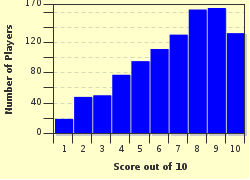Quiz Answer Key and Fun Facts
1. Genetics was fathered by the Austrian monk, Gregor Mendel. He noticed through a long period of experimentation that variation in plants follows inherited patterns. What plant was used to aid his discovery?
2. Genetics and inheritance can be represented diagrammatically. The genes of parents are crossed and the possible outcomes are listed. This demonstrates the probabilities of heredity, but, what is the name of this diagram?
3. Humans are diploid organisms and as such have two copies of most genes. Offspring which show variation are produced by one of the two genes being inherited from the father and the second from the mother. What are these alternative genes known as?
4. Sexual reproduction adds variation to the gene pool of organisms. The variation is produced by the gametes (sperm and ova), however, by what process are these sex cells formed?
5. The genetics of an individual can be responsible for some horrendous conditions. Such conditions can either be inherited from the parents or they can be acquired by genetic mutations. Which of the following types of mutation does NOT lead to what is known as a 'frame shift'?
6. The study of genetics isn't complete without the incorporation of statistics. What is the name given to the equation and equilibrium which together explicate constant proportions of alleles and subsequent genotypes down the generations in a given population?
7. Genetics is at the heart of the Theory of Natural Selection which in turn heavily supports the science of evolution. The man behind the aforementioned theory was none other than the British naturalist Charles Darwin; either admired or loathed depending on your interpretation of the origins of existence. What was the type of bird that Darwin studied in the Galapagos Islands that changed science in a way that was comparable to Newton's analysis of gravity?
8. Despite the theories of Charles Darwin being the widely accepted and revered explanation of evolution and natural selection, there do exist other explanations suggested by scientists. What was the name of the botanist and zoologist (1744-1829) who suggested that organisms evolve by a natural tendency or force that drives an organic structure from simplicity to complexity?
9. The genetics of an individual determines their natural hair colour and eye colour and many other things. An important phenotype that is also determined by genetics is blood groups of which there are eight types (ABO system). These are A+, A-, B+, B-, O+, O- and also AB+ and AB-. However, which of the following terms covers the concept involved in the development of the AB+ and AB- blood groups?
10. Simply put, the differences in the genetics of organisms result in the great diversity of species that we see around us. All organisms are classified according to their genetics and their subsequent phenotypes. What is the name given to the classification of organisms into kingdoms such as plantae, animalia and fungi?
Source: Author
jonnowales
This quiz was reviewed by FunTrivia editor
crisw before going online.
Any errors found in FunTrivia content are routinely corrected through our feedback system.

